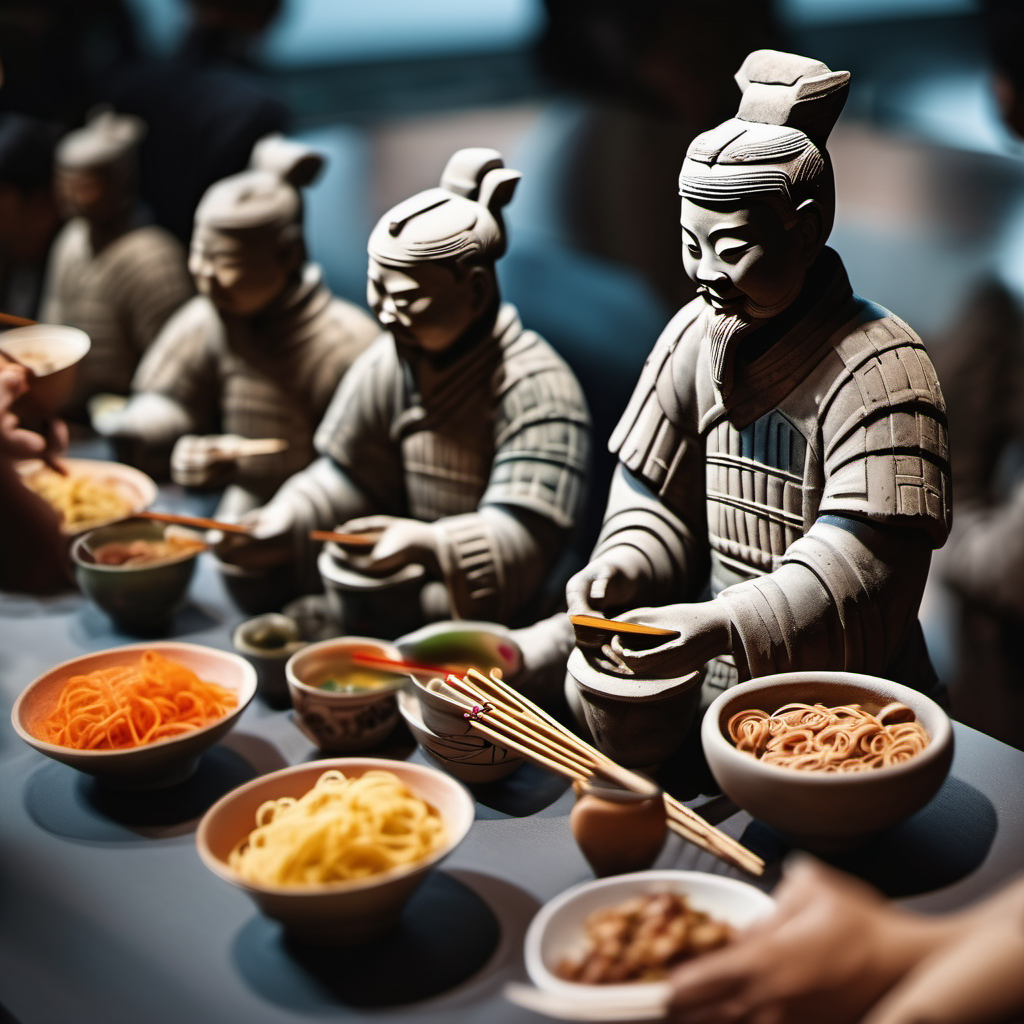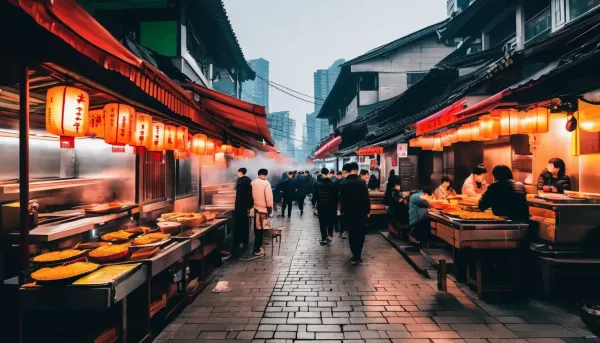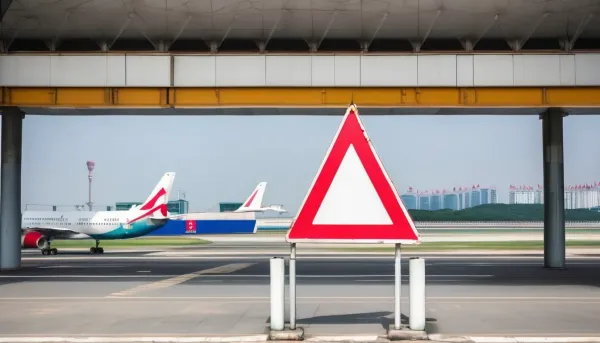Xi'an: A Culinary Capital Far Beyond the Terracotta Warriors
In Xi'an, each dish tells a story, each bite offers a taste of history, and each meal is an opportunity to connect with the rich and diverse culture of this remarkable city.

When one thinks of Xi'an, the first image that likely comes to mind is the Terracotta Army, that incredible assembly of ancient sculptures guarding the tomb of China's first emperor, Qin Shi Huang. But beyond these historical marvels, Xi'an boasts a vibrant and diverse culinary scene that beckons food enthusiasts from around the world. With a rich history as the starting point of the Silk Road, Xi'an's cuisine is a tapestry woven with influences from both East and West, resulting in a gastronomic wonderland that is as diverse as it is delicious.
A Melting Pot of Flavors
Xi'an's strategic location at the crossroads of ancient trade routes made it a melting pot of cultures and, consequently, a melting pot of flavors. The city's cuisine reflects this, featuring a blend of Chinese, Middle Eastern, and Central Asian influences. This unique culinary heritage can be tasted in every bite, from street food stalls to fine dining establishments.
One of the most iconic dishes in Xi'an is the famous Yang Rou Pao Mo, a hearty lamb soup served with crumbled flatbread. The dish is a testament to the city's historical links with the Middle East, where lamb is a staple ingredient. The preparation of Yang Rou Pao Mo is an art in itself; diners are often given a piece of dense, round bread to tear into small pieces before the rich, aromatic lamb broth is poured over it, allowing the bread to soak up the flavors.
Street Food Paradise
For those who love street food, Xi'an is a paradise. The bustling Muslim Quarter, also known as Huimin Street, is a vibrant epicenter of culinary delights. Here, the air is thick with the aroma of grilled meats, spices, and freshly baked bread. A stroll through this lively market is an adventure for the senses.
A must-try in the Muslim Quarter is Rou Jia Mo, often dubbed the "Chinese hamburger." This delicious snack consists of tender, flavorful meat, typically pork or beef, stuffed into a crispy flatbread. The meat is slow-cooked with a blend of spices, resulting in a juicy and aromatic filling that pairs perfectly with the bread's crunch.
Another street food staple is Biang Biang Mian, thick, hand-pulled noodles known for their distinctive shape and texture. These noodles are typically served with a spicy, tangy sauce and topped with a variety of ingredients like vegetables, meat, and chili oil. The name "Biang Biang" itself is onomatopoeic, mimicking the sound of the dough being slapped against the counter during the noodle-making process.
A City of Noodles and Meat
Xi'an's cuisine is characterized by its emphasis on noodles and meat, a reflection of the region's agricultural products and cultural preferences. Unlike the southern parts of China, where rice is the staple, Xi'an's food culture revolves around wheat-based products. This means that visitors will find a plethora of noodle dishes, dumplings, and breads, all of which showcase the versatility and creativity of the city's culinary traditions.
Delicacies with a Story
Many of Xi'an's culinary delights come with fascinating stories that reflect the city's rich history. Take, for example, Guo Kui, a type of stuffed flatbread that dates back to the Tang Dynasty. Legend has it that this snack was created for soldiers, as it is easy to carry and can be eaten cold or hot. The bread is typically stuffed with a savory filling of meat and vegetables, making it a convenient and satisfying meal.
Then there's Dumpling Banquet, a feast that showcases the artistry and variety of Xi'an's dumplings. This banquet features a wide array of dumplings, each with unique shapes, colors, and fillings. Some are shaped like animals, while others are delicately wrapped to resemble flowers. The fillings range from classic pork and cabbage to more exotic combinations like shrimp and sea cucumber.
Fusion and Innovation
While traditional dishes remain a cornerstone of Xi'an's culinary scene, the city is also home to innovative chefs who are pushing the boundaries of Chinese cuisine. Fusion restaurants are popping up, offering creative dishes that blend traditional Chinese flavors with international influences.
One such example is Xian Fusion Kitchen, where you can find dishes like Peking duck tacos and Sichuan pepper-infused pizzas. These inventive creations highlight the versatility of Chinese ingredients and demonstrate how Xi'an's culinary scene is evolving while staying true to its roots.
International Connections and Travel Tips
Xi'an is well-connected to the world through the Xi'an Xianyang International Airport. However, many international visitors might find it more convenient to fly into major hubs like Guangzhou, Beijing, or Shanghai, and then take a domestic flight or high-speed train to Xi'an. The city's efficient transportation network ensures that getting to Xi'an is relatively hassle-free, despite the need for a transfer.
As an inland city, Xi'an's population is generally less proficient in English compared to cosmopolitan cities like Guangzhou, Shanghai, and Beijing. While this might pose a slight challenge for non-Chinese-speaking tourists, the warm hospitality of the locals and the increasing presence of English signage in tourist areas help bridge the communication gap.
Respect for Muslim Traditions
Xi'an is one of China's significant Muslim population centers, home to a large number of Hui Muslims. This cultural diversity is beautifully reflected in the city's culinary scene, particularly in the Muslim Quarter. Visitors should be mindful and respectful of local customs and traditions, such as observing halal dietary laws. Many restaurants in the Muslim Quarter proudly display their halal certification, ensuring that the food adheres to Islamic dietary guidelines.
Climate Considerations
Xi'an experiences a continental climate with hot summers and cold winters. Summer temperatures can soar, making it essential for visitors to stay hydrated and seek shade during the hottest parts of the day. Conversely, winters can be quite cold, necessitating warm clothing and layers to stay comfortable. Spring and autumn are the most pleasant times to visit, offering mild temperatures and beautiful scenery.
A Culinary Journey Awaits
In conclusion, while the Terracotta Warriors are undoubtedly a must-see, Xi'an's culinary offerings are equally deserving of attention. The city's diverse and vibrant food scene, with its rich history and innovative spirit, makes Xi'an a true culinary capital. Whether you're a fan of hearty soups, flavorful street food, or creative fusion dishes, Xi'an has something to satisfy every palate. So next time you find yourself planning a trip to this ancient city, be sure to embark on a culinary journey that promises to be as memorable as its historical sites.
Exploring Xi'an's food scene is not just about the flavors; it's also about the experience. Many restaurants and street food vendors operate in historical buildings, allowing diners to immerse themselves in the city's rich heritage while enjoying their meals. The ambiance of these establishments, with their traditional decor and warm hospitality, adds an extra layer of enjoyment to the dining experience.
Moreover, Xi'an's food culture is deeply intertwined with its festivals and traditions. During the Chinese New Year, for example, the city comes alive with food markets and special dishes that are only available during the festive season. These culinary traditions provide a glimpse into the cultural fabric of Xi'an and offer a unique way to experience the city's heritage.
So, as you explore the ancient wonders of Xi'an, don't forget to indulge in the culinary treasures that await you. Each dish tells a story, each bite offers a taste of history, and each meal is an opportunity to connect with the rich and diverse culture of this remarkable city.



